This is an Ilford Witness, a 35mm rangefinder camera made in 1953 by Peto Scott Electrical Instruments for Ilford of London, England. The Witness was a very ambitious camera, first designed in 1947 by ex employees of Leitz and Zeiss-Ikon. It incorporated a unique hybrid screw/bayonet lens mount, focal plane shutter capable of up to 1/1000 and a combined coincident image rangefinder in a sleek and attractive body. Four years would pass before a working prototype was produced and another two more before the camera went on sale. When it finally did, production delays, poor marketing, and a feature set that was no longer as innovative as when the camera was first designed, doomed it. The Ilford Witness was available only for a short time and less than 350 are thought to have been made.
Film Type: 135 (35mm)
Lens: 2″ (50.8mm) f/1.9 Dallmeyer Super-Six Anastigmat coated 6-elements
Lens Mount: Ilford Witness Combined Screw/Bayonet
Focus: 3 feet to Infinity
Viewfinder: Coincident Image Coupled Rangefinder
Shutter: Cloth Focal Plane
Speeds: T, B, 1 – 1/1000 seconds
Exposure Meter: None
Battery: None
Flash Mount: Cold shoe and Adjustable 0-30ms Flash Sync
Weight: unknown
Manual: None
The Voncabbage Collection
 In the fall of 2021, I had the opportunity to visit the Voncabbage Collection, one of the largest private collections of cameras in the world. The owner of this collection wishes to remain anonymous, but granted me full access to thousands of rare and unusual cameras, many of which were prototypes, one offs, or rare cameras that many collectors would go their whole lives and never see.
In the fall of 2021, I had the opportunity to visit the Voncabbage Collection, one of the largest private collections of cameras in the world. The owner of this collection wishes to remain anonymous, but granted me full access to thousands of rare and unusual cameras, many of which were prototypes, one offs, or rare cameras that many collectors would go their whole lives and never see.
Although I was able to handle and photograph any camera I wanted, when faced with literally thousands of cameras, there’s only so much time you can spend with each one. The owner let me photograph anything I wanted, but there wasn’t enough time to shoot film in any of them.
This year, I will be sharing some of the photos of cameras I took in a series of Voncabbage Collection reviews, along with whatever I could find about each one.. These reviews will be shorter, and sometimes missing things that I was unable to discover in the short time I handled them, but I’ll still do my best to find whatever I can!
History

Mention the name “Ilford” to any film photographer today or from the past 100 years and they’ll likely tell you about one of the company’s excellent black and white films. Emulsions like HP5, FP4, and Delta have lineages that go back nearly a century and along with Kodak, Fuji, and AGFA are one of the most respected makers of photographic film in the world.
What fewer will think of were the company’s short lived forays into making cameras. Like most other makers of film, Ilford was a film first company. At various points in their history, whenever a camera was made bearing their name, it was likely sold to help generate more customers for their film. The thought was that the more people who owned an Ilford camera, the more people might buy Ilford film.
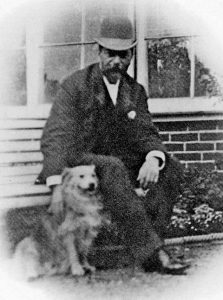
The origins of Ilford date back to a studio photographer named Alfred Hugh Harman who in the 1860s specialized in calotypes and other artificial light photography. In 1879 Harman would abandon his studio and started making photographic gelatine plates in the basement of his home. Initially doing all the work himself, Harman eventually hired staff to help him keep up with the demand from the quickly growing photographic industry.
In 1883, Harman expanded to a larger location in East London where he could grow his business. The company operated under the name Britannia Works and in 1891 became a publicly traded company. The company would rename in 1898 as The Britannia Works Limited and once again in 1900 to Ilford Limited, a name taken from the the town the company was located in.

Shortly after the turn of the century, Ilford’s business continued to grow, and in 1902 released it’s first camera, the Ilford Falling Plate Camera. This simple device, in the shape of a wooden box, used the company’s quarter plates and was advertised as being able to shoot 40 exposures without reloading. The camera came with a variety of lenses made by companies like Ross and Bausch & Lomb.
Over the next couple of decades, Ilford’s business continued to prosper. By the start of World War II, the British government declared Ilford to be essential to the war effort, providing necessary aerial reconnaissance supplies. It was classified by the war department as a Scientific Instrument Maker and munitions factory. This allowed the company to receive prioritization of raw materials and other types of economic protection.
With Germany’s participation in World War II, photographic cameras and other supplies from Germany came to a screeching halt. Companies from all over the world scrambled to fill the void of Leica cameras and Zeiss lenses that were no longer available.
Around 1947, Ilford took the charge to built England’s finest 35mm camera, a model that would compete with or exceed the high quality mark set by cameras like the Ernst Leitz Leica and Zeiss-Ikon Contax. To help them take on such an ambitious project, Ilford hired two former German/Jewish employees of Leitz and Zeiss-Ikon, Robert Siegmund Sternberg and Werner Julius Rothschild.
Both Sternberg and Rothschild started working on a new interchangeable lens 35mm rangefinder camera that would take the best of both the Leica and Contax, and create an entirely new camera from the ground up. Initial development on Ilford’s new camera was slow as it would take three years before any prototypes were shown.
Early examples of Ilford Witness prototype cameras and lenses were manufactured by Rothschild’s company, Northern Scientific Equipment Ltd as Ilford lacked the equipment to build them. Production of the cameras at NSE was very slow and caused further delays in mass producing the camera. It would take another two and a half years before the first models were available for retail sale in late 1952.
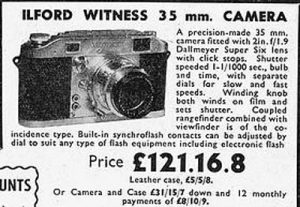
The ad to the left from April 1953 showed the Ilford Witness for sale with a price of £121.16s.8d, which according to the Bank of England’s inflation calculator, compares to about £3625 today. That price, converted to USD compares to just under $5000 today, a monumental price for an all new camera from a company only known for it’s film.
In addition to it’s high price, in between the time when the camera was first conceived in 1947 to when it was actually available, the camera industry had changed wildly. For starters, the German camera industry had recovered and imports of German cameras were easy to get, but also the dawn of the Japanese camera industry had already started trickling in well built and reasonably priced alternatives, making a premium British camera a tough sell.
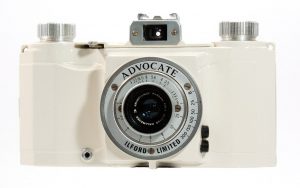
Sales of the Ilford Witness were extremely poor with less than 350 thought to have ever been made. It would seem that the failure of the camera was already apparent to Ilford before it’s release as the company had already started investing in much simpler and less expensive cameras like the Ilford Advocate and Envoy box cameras.
Production of the Witness ended in 1953 with remaining inventory sold by local photographic retailers for as low as £80 each.
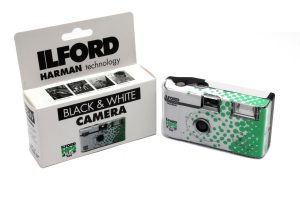
Over the next couple of decades, cameras with the Ilford name would continue to be made, but none with anywhere near the quality or features as the Witness. Production of most Ilford cameras was outsourced first to OEM German manufacturers and later Japanese makers. Single use cameras with the Ilford name and loaded with one of the company’s current black and white films can still be bought today for slightly more than the price of a single roll of film, making them ideal for those curious about film and wanting to try it for themselves without having to invest in expensive used equipment.
Today, cameras like the Ilford Witness are hard to categorize. Normally I would describe them as highly collectible, but their rarity and extremely high prices make them nearly impossible to find. With prices as high as $15,000 in the used market and less than 350 ever made, only the most deep-pocketed collectors have one, and rarely put them up for sale.
Still, with their gorgeous design, long list of features, and historical significance, if you ever have the opportunity to be in the room with an Ilford Witness, I definitely recommend it as there truly was never another camera made like it.
My Thoughts
 I saw many cool cameras during my visit to the Von Cabbage Collection. This collection is spread apart in multiple display cabinets located in multiple rooms across a very large house, so upon my arrival, one of the first cameras that jumped out at my from the first cabinet I looked at, was this Ilford Witness. I had read a little about this camera before and knew how rare it was, and upon picking it up, I we well aware of how special of a camera this was.
I saw many cool cameras during my visit to the Von Cabbage Collection. This collection is spread apart in multiple display cabinets located in multiple rooms across a very large house, so upon my arrival, one of the first cameras that jumped out at my from the first cabinet I looked at, was this Ilford Witness. I had read a little about this camera before and knew how rare it was, and upon picking it up, I we well aware of how special of a camera this was.
The Ilford Witness was the product of both Zeiss and Leitz. It is thought that the two men who designed this sought to include what was good about both the Contax and Leica, without copying either. From the Contax, a wide base length coupled coincident image rangefinder, and a bayonet lens mount were used, but from the Leica, a horizontally traveling focal plane shutter with separate slow and fast speed dials, and a M39 screw lens mount….
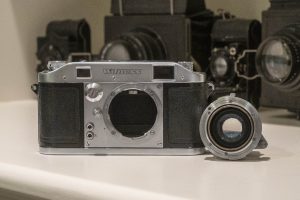
Wait a minute, didn’t you just say it had a bayonet lens mount? How could it also have an M39 mount?

The Ilford Witness had what the company called an ‘interrupted thread mount’ which has the same size and diameter and has the same thread pitch as the M39 Leica Thread except the threads themselves are broken into separate individual bayonets.
Mounting a lens made for the Ilford Witness is done like any bayonet mount, simply align the lens, press it onto the body and give it a quick twist until it locks into position. To remove it, press the tiny release button at the 9 o’clock position around the mount.
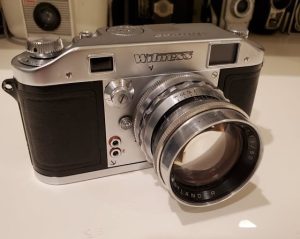
In order to maintain compatibility with Leica lenses, you could also mount a regular M39 screw mount lens as the Ilford has the same threads for those as well. In the image to the left, you can see how the lens has threads, but broken into distinct pieces, like a bayonet lens would have.
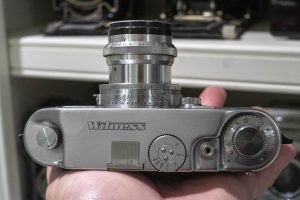
The top plate of the camera is sleek and cleanly designed. Starting with a standard looking pop up rewind knob on the left, an engraved Witness logo stretches across the top plate with a flush mounted accessory shoe below it. A spring loaded piece of metal maintains a flat appearance when not in use, but when something needs to be attached, retracts into the body.
Continuing with the sleek lines is the round shutter speed dial with options for speeds 1/25 to 1/1000 plus B/T. Slow speeds are selected by setting the dial to the 1-25 position and then changing them using a second dial on the front of the camera.
Next is the cable threaded shutter release and combined film advance knob and exposure counter. The exposure counter counts exposures made and must be manually reset after loading in each new roll of film.
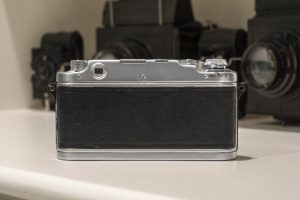
The back of the camera has the round opening for the viewfinder eyepiece, and a sliding switch below the advance knob which controls the direction of the film transport forward (w) or backwards (r).
Flip the camera over and two half circle locking keys are on each side of the baseplate for opening the camera. Flip up and twist both keys 180 degrees and the entire back and bottom comes off.
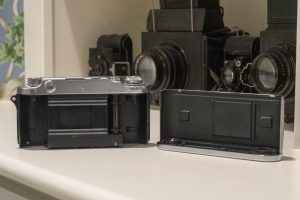
The Witness film compartment is finely crafted in an ordinary way. All surfaces have a flat black paint that shows little signs of wear. No metal edges are present suggesting some effort was put into making sure nothing could snag or scratch film as it passes through the camera. A painted metal pressure plate is attached to the inside of the door. While not exceptionally big, it feels like a solid piece of metal that will do it’s job without issue.
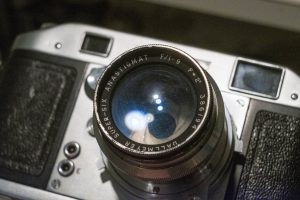
Without a doubt, the most exciting thing about the Witness was it’s f/1.9 Dallmeyer lens. Had I been able to shoot the camera, I would have expected to see results at least on par with an f/2 Summitar or f/2 Sonnar. Since the Witness has DNA from both Leitz and Zeiss, this seems like a plausible conclusion.
Since the Witness lens mount is interchangeable with M39 screw mount lenses, even with a dead Witness body, this lens could have been used with an M39 adapter on any modern digital camera.
The last part of the Witness worth mentioning is it’s viewfinder. Externally, the base length between both the viewfinder and rangefinder window appears to be the same as the Zeiss-Ikon Contax IIa and IIIa. I didn’t have a ruler handy, but looking at the cameras side by side, the distance appears to be the same 73mm, meaning rangefinder accuracy would have been quite good with telephoto lenses.
The viewfinder on this example showed signs of haze and debris, making it’s rangefinder patch difficult to see. I did not get a chance to shoot a through the viewfinder image when I was handling the Witness because it was so difficult to see through. The external dimensions of the viewfinder are not the only way it’s viewfinder reminds me of the Contax as looking through it seemed very familiar as well. I have no proof of this as I’ve never seen a Witness with it’s top plate removed, but I would be surprised if under there isn’t an exact, or at least very similar copy to Zeiss’s complex prism design.
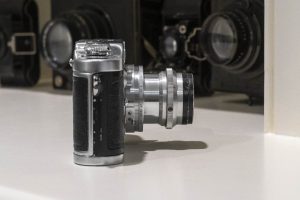
The Ilford Witness is an impressive camera. Not only because of it’s looks and features, but that it even exists at all. There’s a saying “the road to hell is paved with good intentions” and after World War II, the good intentions of two very skilled designers got to work on what should have been a game changing camera.
Of course, that’s not what happened. If it was easy to design a Leica or Contax killer, then it’s likely there would have been more cameras to compete with those models, but of course, there’s Leicas and Contaxes, and there’s everything else.
The entire process of creating the Witness from start to finish took nearly 7 years and by the time the camera was ready, the world had passed it by.
When it comes to collectable cameras, it doesn’t get much more exciting than the Witness. Despite it’s troubled history, when I handled the camera, it never felt cheap or suggested it’s ultra low production numbers. Although I didn’t get a chance to shoot the camera, I felt that had I done so, the experience would have been positive. The camera has excellent ergonomics, all of the necessary controls are exactly where they belong, the viewfinder has DNA from the best cameras of the day, and the lens was made by a company with a great deal of experience.
I doubt I’ll ever get a chance to shoot another Ilford Witness, but if I do, of course I’ll come back and update this review, but using my imagination, I am quite certain I’ll enjoy it!
Related Posts You Might Enjoy
External Links
http://camera-wiki.org/wiki/Ilford_Witness
https://www.photomemorabilia.co.uk/Ilford/Witness.html
https://www.9days.hk/post/ilford-witness-a-masterpiece-rangefinder-1-38/

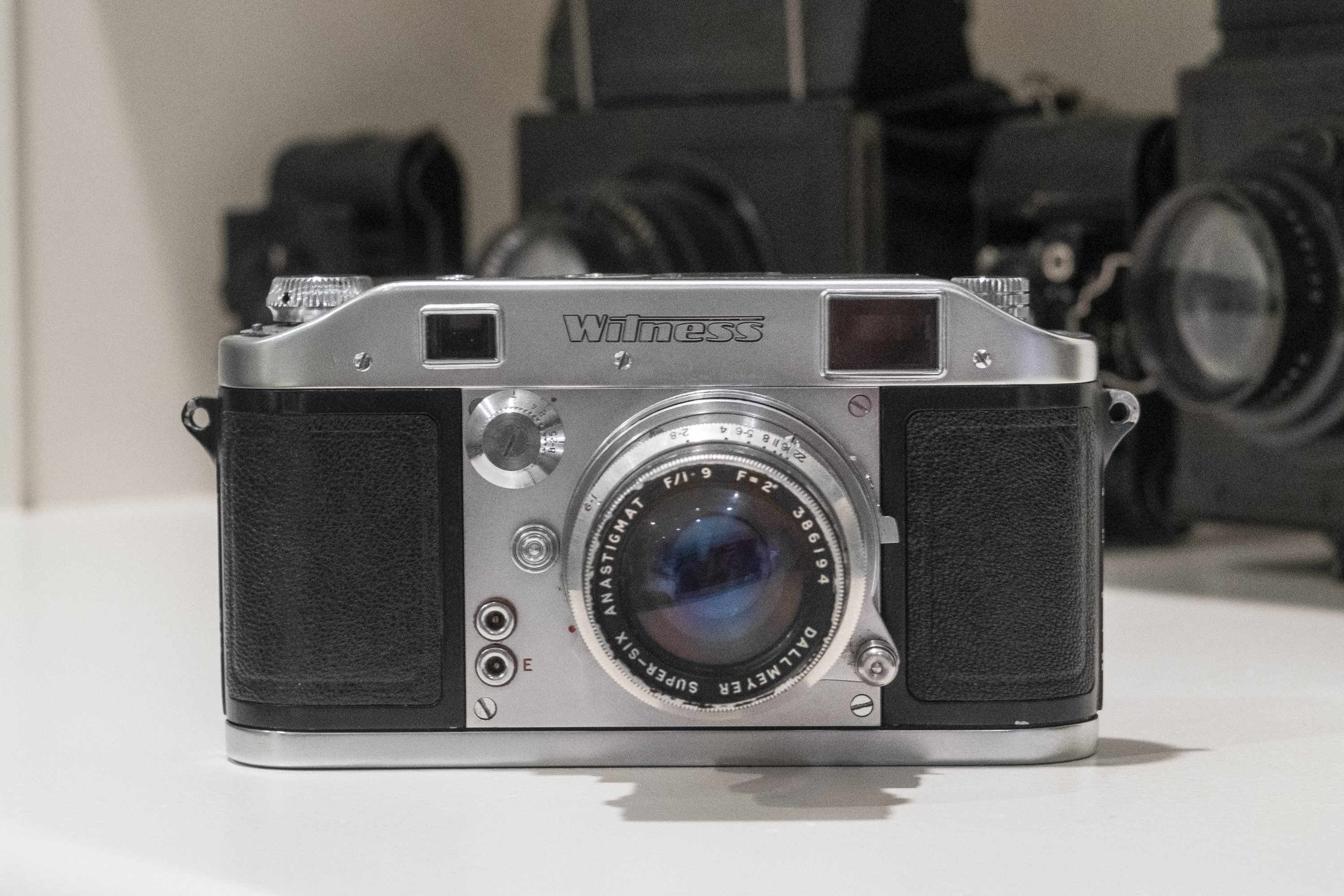
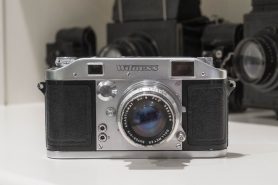
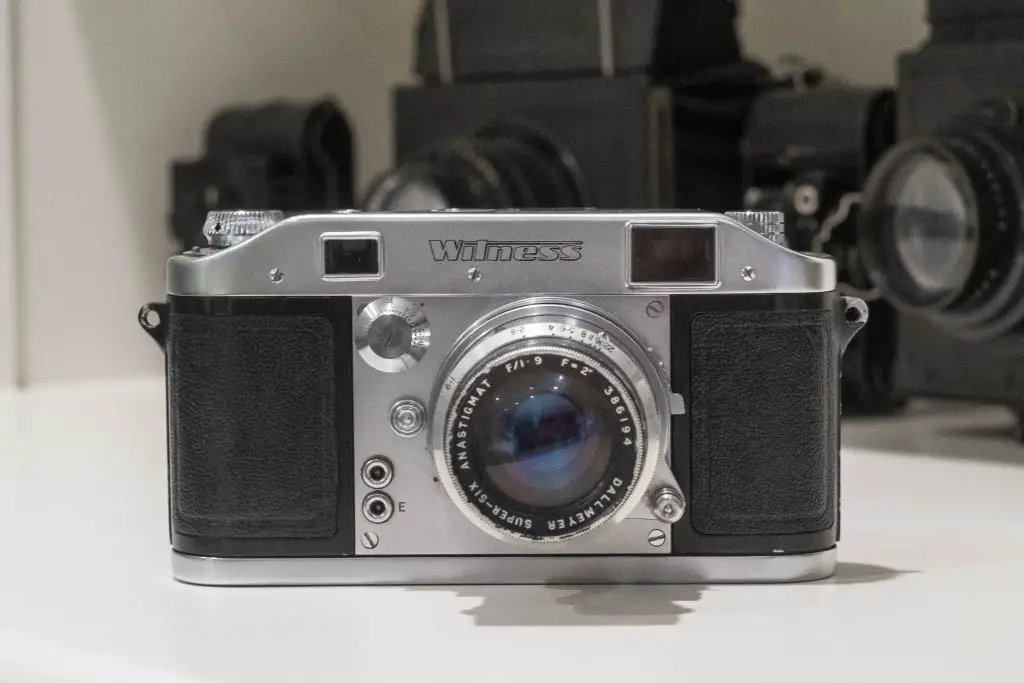
I’ve run across the ‘Von Cabbage” name numerous times on Ebay and have rarely been successful in bidding against him,
when it comes to the rarer pieces of interest. Kinda makes sense now!
What a fine camera. Marketwise, too much and too late. The top plate profile reminds me of the Vokar 35 rangefinder, circa 1946. Also failed in the market due to its price.
Yeah, I definitely see a Vokar resemblance in the top plate, especially the slightly slanted edges and curved corners! My only regret is not getting a chance to actually shoot this thing!